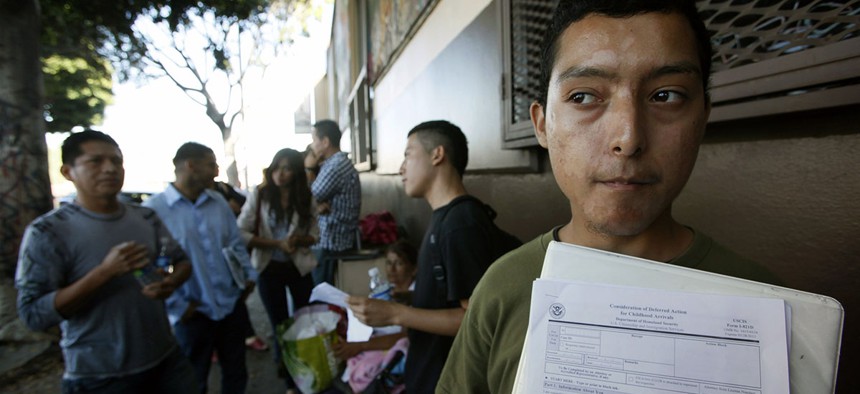DHS Calls Over-Cost Delayed Immigration Casework System a ‘Turnaround Story’

Illegal immigrant Layios Roberto waits outside the offices of Coalition for Humane Immigrant Rights in Los Angeles. Nick Ut/AP File Photo
But the inspector general found that after 11 years, caseworkers have difficulty using the tool, which also offers only two of about 90 forms, and technical support is inadequate.
Correction: An earlier version of this story incorrectly attributed statements to a USCIS spokesman. In fact, they should be attributed to USCIS Director Leon Rodriguez. The story has been corrected.
The Department of Homeland Security insists plans for a $3.1 billion system to digitize immigration casework are on track, despite an internal watchdog finding little progress has been made on the beleaguered project since 2005.
The Electronic Immigration System, or ELIS, initially was designed as a "waterfall" project that would roll out all at once by its expected 2013 completion date. When the anticipated $536 million tool was veering toward a $3.6 billion cost in 2012, with no finish date, DHS switched to an "agile" approach that would activate system features in stages to see if users are comfortable with them.
The inspector general report, published earlier this month, does not evaluate the U.S. Citizenship and Immigration Services' methodology for building the software. Rather, DHS IG John Roth set out to review the results of the agency’s effort to computerize the processing of visas, green cards and other immigrant applications. Roth discovered that after 11 years, caseworkers experience difficulty using the tool, it offers only two of about 90 forms, and technical support is inadequate.
"This Office of the Inspector General report does not fully recognize the extent of USCIS’ efforts to implement new technology and the extraordinary impact that these changes have had on the effectiveness of the system," Leon Rodriguez, the agency’s director, said in a statement provided to Nextgov in a Friday afternoon email.
"The report did not look at or assess any of the changes made by the program, instead assessing it from the perspective of the users of fielded capability,” he added. “As a result, several of the report’s central findings and recommendations do not reflect the drastically improved approaches put into place as we rebuilt our Electronic Immigration System."
A June 2015 Government Accountability Office audit did assess the overhaul and found the approach flawed, a point Roth noted in his own audit.
Carol Cha, GAO director of IT acquisition management issues, said in her report the "changes have significantly delayed the program’s planned schedule, which in turn has had adverse effects on when USCIS expects to achieve cost savings, operational efficiencies, and other benefits."
For example, she said, a March 2013 choice to transition to a new IT setup was partly based on cost savings that did not account for the added expense of merging data from the old architecture.
Today, the agency says ELIS is the archetype of industry innovation and government project development.
"The USCIS Transformation program is widely considered a model for bringing private sector best practices into government programs. The practices used to create ELIS are the same as those used by leading technology companies like Netflix, Amazon and Google. Other government agencies regularly visit Transformation to learn about these contemporary best practices," Rodriguez said.
Roth had said in his final audit there is no basis for this claim.
In the Friday email, however, Rodriguez said, "Over the past several years, USCIS has undertaken a massive and successful overhaul of our immigration benefit processing technologies."
He acknowledged the earlier build-out method is now known to be deeply flawed.
"USCIS was aware of the program’s problems in 2011 and in 2012, and we made tough decisions and fundamentally changed our approach," he said.
In addition, he said the inspector’s report does not indicate key improvements made after the audit period.
"Suffice to say, where we are today bears little resemblance to the troubled processes of the past that the Office of the Inspector General reported on," Rodriguez said. "The truth of the matter is that this program is a turnaround story, and we are moving in the right direction."






